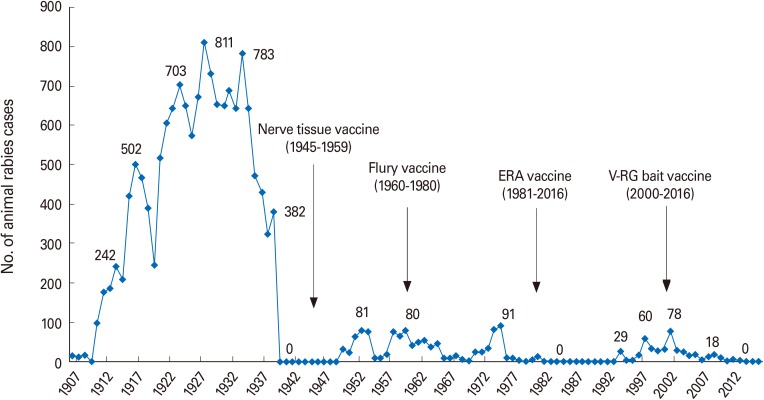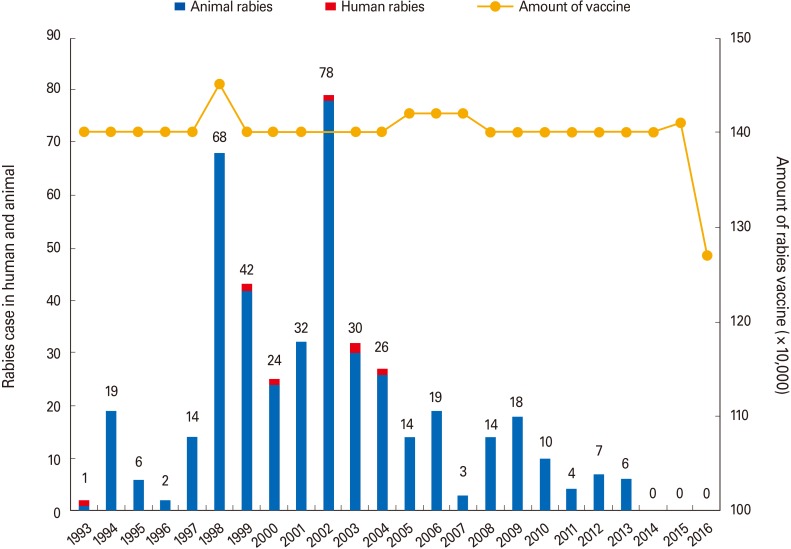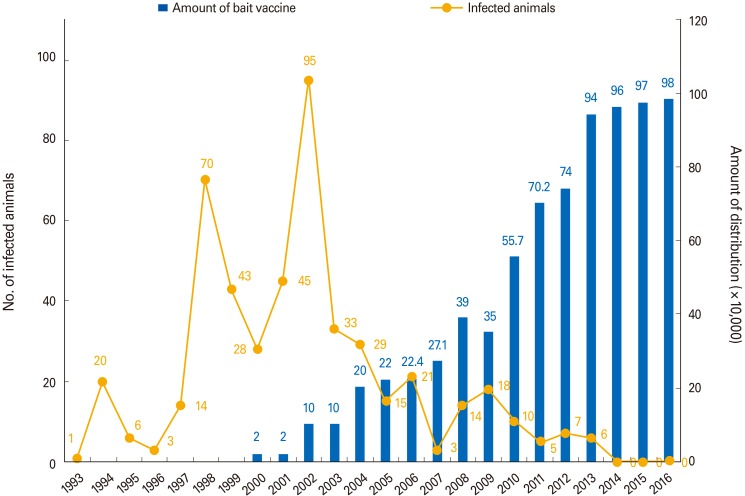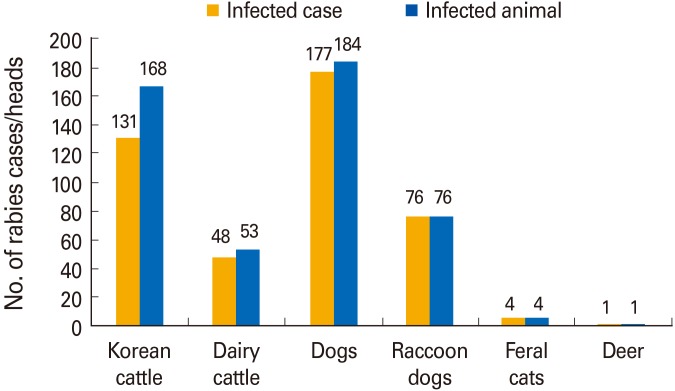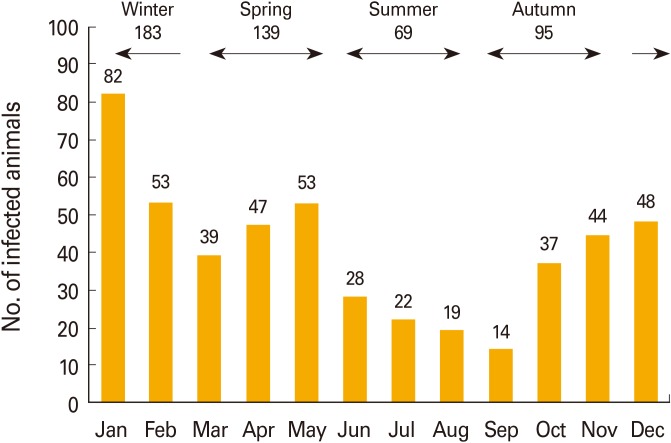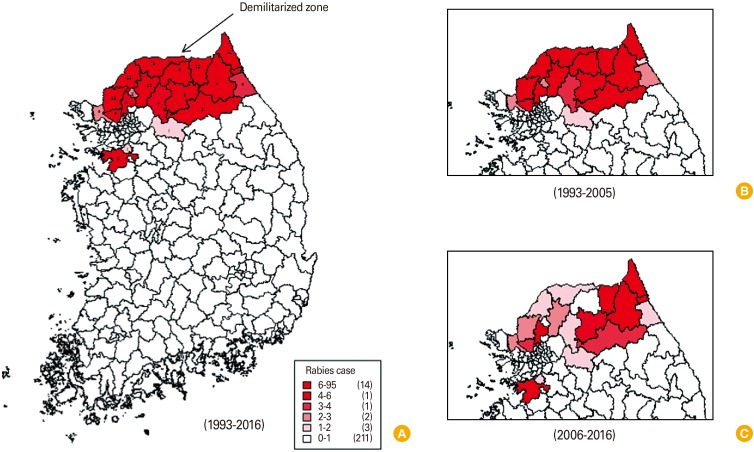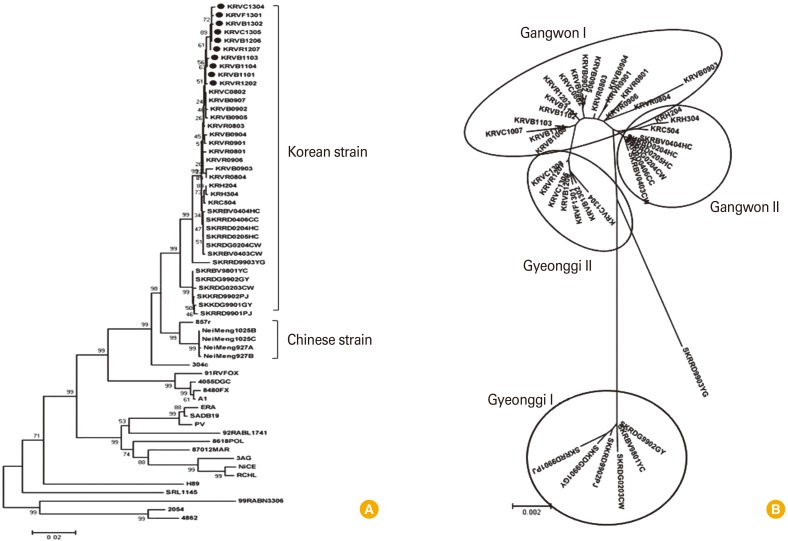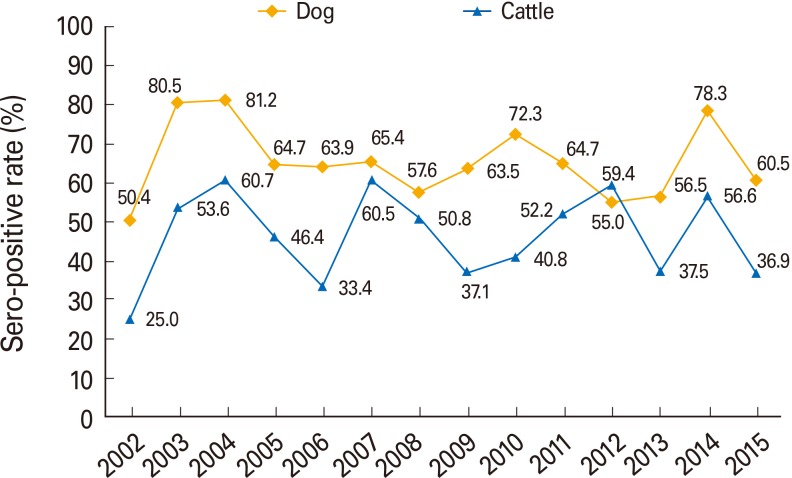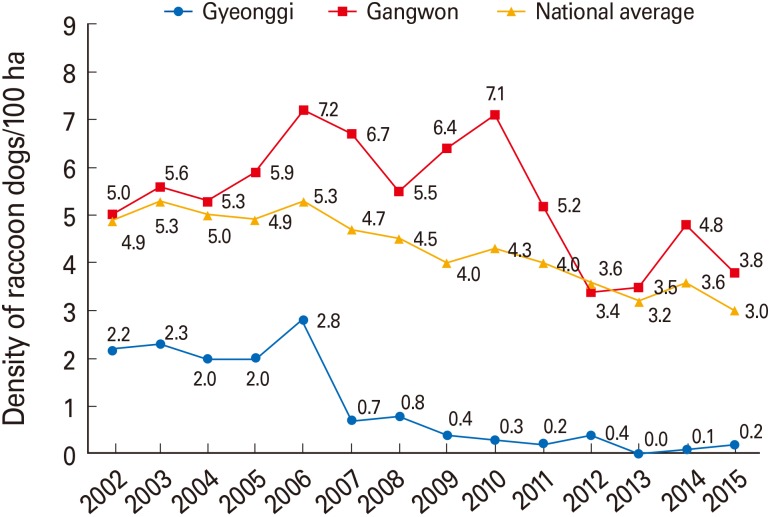Abstract
Purpose
Rabies is one of the most fatal diseases, but it is 100% preventable in animals by vaccination. In this study, we present the epidemiological features of, and national preventive measures against, rabies in Korea.
Materials and Methods
Data related to rabies and the population density of raccoon dogs in Korea were collected from the Animal and Plant Quarantine Agency, the Korean Centers for Disease Control and Prevention, and the National Institute of Environmental Research. Rabies diagnosis was confirmed with a fluorescent antibody test using brain samples of animals in accordance with the procedures described by the World Organization for Animal Health. Serological assays for dogs and cattle were conducted using the fluorescent antibody virus neutralization test.
Results
From 1993 to 2016, a total of seven human rabies cases and 437 animal rabies cases in five different species were reported. An increase in the distribution of bait vaccine seemed to be related to a dramatic decrease in rabies prevalence in endemic rabies regions. Two Korean provinces and the capital city, Seoul, were involved in rabies outbreaks. Korean rabies strains are most closely related to the eastern Chinese strain belonging to the Arctic-like lineage. The yearly seropositive rates ranged from 50.4% to 81.2% in dogs and from 25% to 60.5% in cattle residing in endemic rabies regions.
Conclusion
This study indicates that national preventive measures, including mass vaccination and distribution of bait vaccines, have contributed to a substantial decrease in the number of rabies cases in Korea.
Keywords: Epidemiology, Rabies, Disease eradication, Korea
Introduction
Rabies is a fatal zoonotic disease caused by the rabies virus (RABV), which belongs to the Lyssavirus genus of the Rhabdoviridae family [1,2]. Once the clinical symptoms of rabies develop, death occurs in 100% of infected individuals. Although rabies is known to be a preventable viral disease through vaccination, it occurs in more than 150 countries. Recently, two Asian countries, Malaysia and Taiwan, lost their status as rabies-free due to outbreaks in dogs [3].
Over 95% of human rabies cases are closely related to canine rabies, and animal rabies originates from many natural reservoirs [4]. Rabies is transmitted through the bites of several species of animal, including dogs, bats, raccoon dogs, wolves, and mongooses; the source varies by country [5]. Recent animal rabies cases in Taiwan were related to ferret badgers (Melogale moschata) and the rabies cases that have occurred in South Korea since 1993 have been associated with raccoon dogs (Nyctereutes procyonoide) [6,7].
Analyzing the spatial and chronological distribution of rabies cases is critical to forecast its spread into nearby regions. Animal rabies has distinct clinical signs, such as excessive salivation and abnormal behavior, and reported animal rabies cases are useful with respect to implementation of preventive activities to control the disease. Spatial models have been used to forecast raccoon-related rabies emergencies [8], and an analysis of human rabies cases in Chinas used spatial clustering [9].
Molecular epidemiological studies have contributed to a better understanding of the geographic relationships among rabies outbreaks, and have been used to determine the sources of infections [10,11]. The nucleocapsid (N) gene and protein have been targets for the diagnosis of rabies via the fluorescent antibody test (FAT) and reverse transcriptase polymerase chain reaction, because the N gene is highly conserved and large amounts of the N protein are produced in the infected brain [12]. In the past, sero-surveys were considered to be of little value for determining rabies epidemiology because rabies antibodies were detected on the verge of death [13]. However, rabies sero-surveillance has been used to monitor the immune status of dogs and cattle after vaccination. Rabies antibodies can be measured by several methods, including the rapid fluorescent focus inhibition test (RFFIT), fluorescent antibody virus neutralization (FAVN), and enzyme-linked immunosorbent assays. Both the RFFIT and FAVN tests are recognized as reference assays by the World Health Organization (WHO) and the World Organization for Animal Health (OIE). In South Korea, enhanced rabies eradication programs, including mass vaccination and distribution of rabies bait vaccine in rabies endemic regions, have been implemented in an effort to eliminate rabies by 2020 in accordance with the recommendations of international organizations. In this study, we analyzed the epidemiology of rabies in Korea and evaluated the preventive measures initiated by the Korean Veterinary Authority over a period of 23 years, from 1993 to 2016.
Materials and Methods
Collection of data
Detailed data on all animal rabies cases that were reported to the Animal and Plant Quarantine Agency (APQA) of Korea between 1993 and 2016 were collected. Data concerning human rabies cases during the same period were collected from the Korea Centers for Disease Control and Prevention. We also referred to epidemiological reports of rabies cases written by local Veterinary Service Laboratories (VSLs), which contained details concerning the population affected, location, time of onset, clinical findings, and suspected etiology. Data concerning the quantities of rabies vaccine and bait vaccine given were collected from the Planning and Implementation of Livestock Prevention Project. National data on raccoon dog population density between 2002 and 2015 were collected from the National Institute of Environmental Research.
Diagnosis of rabies
Animals suspected of having rabies were examined at the APQA or local VSLs, and the brains of the animals were removed. To confirm a rabies diagnosis, a FAT was performed on the brain samples of animals using the procedure described by the OIE [14]. Briefly, thin, frozen sections of the hippocampus were fixed on a slide with cold acetone (-20℃) for 20 minutes. The samples were subsequently reacted with a specific monoclonal antibody (MEDIAN diagnostics, Chuncheon, Korea) against rabies and stained with fluorescent isothiocyanate conjugated goat-anti mouse IgG+IgM. The samples showing specific fluorescence in the treated section of the hippocampus were diagnosed as positive.
Spatial analysis
The locations of rabies cases were depicted on a map. The location of each outbreak site or farm was identified using data from the KAHIS program (http://www.kahis.go.kr) and depicted as colored areas using the Map Wizard for Excel (Tastech, Seoul, Korea).
Phylogenetic analysis
For the analysis of nucleotide sequences coding the N gene of Korean RABV, a total of 61 RABV isolates containing 40 Korean RABV isolates were obtained from GenBank. Phylogenetic trees were reconstructed on aligned nucleotide sequences using CLUSTAL W. Bootstrap analysis was used to determine the robustness of the phylogenetic tree with 1,000 replications performed using MEGA6 software. Graphical output was produced using TreeView software (ver. 1.6.1; http://rana.lbl.gov/EisenSoftware.htm).
Collection of sera and the serological assay
A total of 14,344 serum samples were collected from dogs and cattle residing in 20 counties of two Korean provinces, and in the capital city, Seoul. Samples were collected from nine counties in Gangwon province (Cheorwon, Chuncheon, Goseong, Hongchong, Inje, Sokcho, Hwacheon, Yanggu, and Yangyang), eleven counties in Gyeonggi province (Dongducheon, Gapyeong, Gimpo, Goyang, Paju, Pocheon, Suwon, Whaseong, Yangju, Yangpyeong, and Yeoncheon), and one county (Eunpyeong) in Seoul. Depending on the year, an average of 40 and 20 samples from dogs and cattle, respectively, were collected from 21 counties. The virus neutralizing antibody test for dogs and cattle was performed using the FAVN test [15], and a positive reference serum sample obtained from the WHO (adjusted to 0.5 IU/mL) was used as a positive control.
Results
Number of rabies cases
A total of 16,134 animal rabies cases have been confirmed in Korea since 1907 (Fig. 1). The average number of rabies cases was 383.6 per year when no rabies vaccine was applied (1907-1944), 30.6 when an inactivated nerve tissue vaccine was used (1945-1959), and 30.6, 12.6, and 16.7 when the Flury vaccine (1960-1980), Evelyn-Rokitnicki-Abelseth (ERA) vaccine (1981-2016), and V-RG vaccine (2000-2016) were used, respectively. As shown in Figs. 2 and 3, from 1993 to 2016, there were 437 animal rabies cases (486 animals infected with rabies) among five different animal species, and seven human rabies cases that resulted in death, in South Korea. Rabies case could be different from number of animals infected with rabies because one or two animals could be infected with rabies in one farm. The highest annual incidence of animal rabies cases (78 cases; 96 animals) occurred in 2002, which subsequently gradually decreased to zero cases in 2014. Approximately 1.4 million rabies vaccines were planned and administered to dogs and cattle nation-wide after 1993. The Korean government distributed 20,000 bait vaccines in 2000, and the number of vaccines was gradually increased to 980,000 with the aim of blocking transmission of raccoon dog-mediated rabies cases in the endemic rabies provinces of Gyeonggi and Gangwon. Among the 486 animals infected with rabies, 184 dogs (37.9%), 168 Korean native cattle (34.6%), 76 raccoon dogs (15.6%), 53 dairy cattle (10.9%), four feral cats (0.8%), and one deer (0.2%) were infected with wild rabies (Fig. 4). As shown in Fig. 5, the average monthly frequency of animal infection peaked in January (82 of 486 total cases) and the seasonal rabies incidence was higher in the winter and spring than during summer and autumn.
Fig. 1. Animal rabies cases reported in Korea since 1907, and the timing of rabies vaccination programs.
Fig. 2. Relationship between the doses of rabies vaccines administered to pets and domestic animals and the number of rabies cases since 1993.
Fig. 3. Relationship between the doses of bait vaccines administered and the number of animal rabies cases since 1993.
Fig. 4. Distribution of rabies cases according to animal species in South Korea since 1993.
Fig. 5. Seasonal and monthly distribution of animal rabies cases in South Korea since 1993.
Regional prevalence of rabies
Raccoon dog-mediated rabies cases first occurred in 1993, as shown in Fig. 6A, and the disease was subsequently confined to the northern part of South Korea, including the Gyeonggi and Gangwon provinces. However, these two provinces are located near the border of the demilitarized zone (DMZ) and the disease outbreaks moved east starting in 2006, and then moved west in 2013 (Fig. 6B, C). Animal rabies cases were recorded in nine counties in Gangwon province (Cheorwon, n=70; Chuncheon, n=15; Goseong, n=29; Hongchong, n=8; Inje, n=13; Sokcho, n=12; Hwacheon, n=18; Yanggu, n=23; and Yangyang, n=3), eleven counties in Gyeonggi province (Dongducheon, n=2; Gapyeong, n=4; Gimpo, n=2; Goyang, n=6; Paju, n=80; Pocheon, n=24; Suwon, n=1; Hwaseong, n=9; Yangju, n=32; Yangpyeong, n=1; and Yeoncheon, n=84), and one county of Seoul (Eunpyeong, n=1) from 1993 to 2016. The region with the highest prevalence of rabies cases among these 21 counties was Yeoncheon (84 cases).
Fig. 6. (A) Distribution of animal rabies cases in South Korea from 1993 to 2016. The regions of occurrence are colored, for the periods 1993-2005 (B) and 2006-2016 (C).
Molecular epidemiology
A nucleotide sequences analysis based on the complete N gene revealed that the highest sequence similarity of Korean isolates with non-Korean RABV corresponded to the Chinese strain, NeiMeng1025B, which was isolated from rabid raccoon dogs in eastern China (Fig. 7A). The nucleotide homology among the 40 Korean isolates ranged between 98.1%-99.8%. As shown in the phylogenetic tree presented in Fig. 7B, the Korean RABVs are divided into four subgroups (Gangwon I and II and Gyeonggi I and II) with high similarity, indicating that Korean RABVs with a narrow variation have circulated within endemic regions without the introduction of new RABVs from other countries.
Fig. 7. Phylogenetic trees showing the relationship between 61 nucleocapsid genes of the rabies virus (RABV) (A) and the classification of 40 Korean RABVs isolated after 1998 (B). RABV isolates in the Gyeonggi II class are closely related to those in the Gangwon I and II classes.
Sero-prevalence and population density of raccoon dogs
The rabies antibodies of 8,677 dogs and 5,677 cattle, bred in 20 counties of the Gyeonggi and Gangwon provinces and one city since 2002, were examined. The average sero-positivity rate of the two provinces was 65.3% and 46.5% in dogs and cattle, respectively. As shown in Fig. 8, the highest sero-positivity rate in dogs and cattle was 81.2% and 60.7%, respectively, in 2004, and the lowest sero-positivity rate was 50.4% and 25.0% in dogs and cattle, respectively, in 2002. Sero-positivity in dogs and cattle tends to show fluctuation. The average nationwide population density of raccoon dogs, which is known to be an important factor in rabies transmission, has shown a continuously decreasing trend since 2002 (Fig. 9). The density of the raccoon dog population was higher in Gangwon province, with an average of 5.4 per 100 hectare, compared with Gyeonggi province, with an average 1.0 per 100 hectare, over the last 14 years.
Fig. 8. Yearly rabies sero-positive rates in dogs and cattle since 2002.
Fig. 9. Population density of raccoon dogs by Korean province. The raccoon dog survey was initiated in 2002.
Discussion
Since rabies was first reported in dogs in South Korea 1907, animal rabies cases have accounted for 90.34% (14,577 of 16,134 cases) of all rabies cases between 1907 and 1944, a period during which no animal rabies vaccination was available. An inactivated rabies vaccine containing rabbit or calf brain tissue infected with wild RABV was used from 1945-1959 [16,17]. During this period, there were 459 confirmed cases (2.84%, 459/16,134) of rabies, but some data are assumed to have been lost due to the Korean War. An attenuated rabies vaccine, named the low egg passage Flury strain, was developed by the Korean Veterinary Authority at the end of the 1950s and used in an extensive vaccination program for the control of canine rabies between 1960 and 1980 [17,18]. During that period, 644 cases (3.99%, 644/16,134) of rabies were recorded, indicating an average of 30.6 cases per year. In 1974, the Canadian ERA vaccine strain was introduced experimentally, and has since been used in the Korean rabies control program for dogs and cattle [16,19]. There were no reported rabies cases from 1985 to 1992. After the advent of the raccoon dog-mediated rabies vaccine in 1993, approximately 140,000 rabies vaccinations per year, including both live and inactivated vaccines, were given to dogs and domestic animals. Moreover, the 20,000 V-RG bait vaccines were distributed in rabies endemic regions in 2000, which led to a dramatic decrease in rabies cases, indicating that the sylvatic form of rabies in wild animals has been inhibited successfully in South Korea.
Since raccoon dog-mediated rabies cases first emerged in South Korea in 1993, the sylvatic form of the disease has flourished in two provinces close to the DMZ, which are considered wildlife-friendly areas. Rabies infection in animals could result from spill over infection from primary reservoirs to other species [20,21]. Since then, a total of seven humans have died from rabies; these cases were closely associated with rabid raccoon dogs. An analysis of rabies regions showed that all cities facing the border of the DMZ had several rabies cases from 1993 to 2005, and the case distribution shifted to the northeastern region of Gangwon, and to two counties—Whaseong and Suwon—located in Gyeonggi province, between 2006 and 2016. Indeed, raccoon dogs were often seen around farms and fighting with dogs before infections were reported. Over the last 23 years, rabies cases in Korea have frequently been observed during the winter months, i.e., from December to February. The incidence was highest in January, which may have been related to the behavior of raccoon dogs, which try to gain weight in the winter. When raccoon dogs are hungry, they may try to find food near cattle farms or villages; in doing so, dogs and cattle might be exposed to rabid raccoon dogs. In contrast, rabies cases are relatively sporadic during the summer due to high food availability.
When comparing the nucleotide similarity of the Korean RABV isolates with those of non-Korean isolates, the Korean RABV isolates showed a closer association with the NeiMeng1025B strain, which was isolated from a naturally RABV-infected raccoon dog in the Jilin province of China. Thus, it is likely that Korean RABVs were transmitted from the northeastern region of China in 1993. Previous molecular epidemiological studies also indicated that RABV in South Korea was closely related to the Arctic-like virus, and that these viruses may have been transmitted from the Far East, via North Korea, by raccoon dogs [22,23,24]. In this study, Korean RABV isolates were classified into four subgroups by geographical region (Gyeonggi I and II, and Gangwon I and II). They had high similarity based on a phylogenetic analysis, indicating that the Korean RABV has circulated within the two provinces since 1993 without introduction of a new RABV from other countries.
It is necessary to vaccinate all animals susceptible to rabies within outbreak areas [5,25,26]. Internationally, over 70% rabies sero-positivity is required for adequate management of rabies in dogs and cattle. Thus, in 2002 Korea's Veterinary Authority initiated a serological test program to strengthen the dog and cattle vaccination program in 20 counties of two provinces of South Korea, as well as the capital city, Seoul. According to our data, the average rate of rabies sero-positivity in dogs and cattle was 65.3% and 46.5%, respectively. Only 4 of 14 years showed sero-positive rates of 70% or greater in dogs, while in cattle no year showed a sero-positive rate >70%. However, it is possible that rabies may recur in dogs and cattle. It is well known that animals with antibody titers <0.5 IU/mL develop severe clinical signs of rabies after challenge with virulent RABV [27]. Thus, all counties that have experienced rabies cases in the past should take further preventive measures, including administering booster injections to animals.
The target of the rabies bait vaccine is the raccoon dog, as this species has played a key role in the transmission of rabies in South Korea during the last 23 years. The bait vaccine has been distributed since 2000 to block rabies transmission by rabid raccoon dogs. Many preventive measures, including oral rabies vaccinations and rabies control programs, have led to a 3-year period of rabies non-occurrence since 2014. To block the re-emergence of rabies transmitted by raccoon dogs, new rabies control programs, such as trap-vaccination-release and point infection control, need to be reviewed and then applied in rabies outbreak regions.
In conclusion, an intensive rabies control program, consisting of vaccination of susceptible animals, distribution of bait vaccines, and serological evaluation after vaccination in rabies endemic regions, was implemented to control animal rabies completely. Even though no rabies cases have been reported since 2014, short- and long-term strategies to prevent rabies recurrence should be established. Additionally, it should be confirmed that no rabies antigen exists in raccoon dogs living in regions at risk for rabies outbreaks during the last 3 years. Finally, future studies performing serological surveys in raccoon dogs are warranted to monitor their immune status according to the distribution of the bait vaccine.
Footnotes
No potential conflict of interest relevant to this article was reported.
The authors thank all the people who were in charge of diagnosis and prevention at APQA and the local Veterinary Service Laboratories.
This work was supported financially by a grant (2016-269) from Korea Institute of Planning & Evaluation for Technology (IPET), Ministry of Agriculture, Food and Rural Affairs (MAFRA), Republic of Korea.
References
- 1.Bourhy H, Kissi B, Tordo N. Molecular diversity of the Lyssavirus genus. Virology. 1993;194:70–81. doi: 10.1006/viro.1993.1236. [DOI] [PubMed] [Google Scholar]
- 2.Wunner WH, Larson JK, Dietzschold B, Smith CL. The molecular biology of rabies viruses. Rev Infect Dis. 1988;10(Suppl 4):S771–S784. doi: 10.1093/clinids/10.supplement_4.s771. [DOI] [PubMed] [Google Scholar]
- 3.Chang JC, Tsai KJ, Hsu WC, et al. Rabies virus infection in ferret badgers (Melogale moschata subaurantiaca) in Taiwan: a retrospective study. J Wildl Dis. 2015;51:923–928. doi: 10.7589/2015-04-090. [DOI] [PubMed] [Google Scholar]
- 4.Sultanov AA, Abdrakhmanov SK, Abdybekova AM, Karatayev BS, Torgerson PR. Rabies in Kazakhstan. PLoS Negl Trop Dis. 2016;10:e0004889. doi: 10.1371/journal.pntd.0004889. [DOI] [PMC free article] [PubMed] [Google Scholar]
- 5.Hankins DG, Rosekrans JA. Overview, prevention, and treatment of rabies. Mayo Clin Proc. 2004;79:671–676. doi: 10.4065/79.5.671. [DOI] [PubMed] [Google Scholar]
- 6.Kim CH, Lee CG, Yoon HC, et al. Rabies, an emerging disease in Korea. J Vet Med B Infect Dis Vet Public Health. 2006;53:111–115. doi: 10.1111/j.1439-0450.2006.00928.x. [DOI] [PubMed] [Google Scholar]
- 7.Oem JK, Kim SH, Kim YH, Lee MH, Lee KK. Reemergence of rabies in the southern Han river region, Korea. J Wildl Dis. 2014;50:681–688. doi: 10.7589/2013-07-177. [DOI] [PubMed] [Google Scholar]
- 8.Recuenco S, Blanton JD, Rupprecht CE. A spatial model to forecast raccoon rabies emergence. Vector Borne Zoonotic Dis. 2012;12:126–137. doi: 10.1089/vbz.2010.0053. [DOI] [PubMed] [Google Scholar]
- 9.Guo D, Zhou H, Zou Y, et al. Geographical analysis of the distribution and spread of human rabies in china from 2005 to 2011. PLoS One. 2013;8:e72352. doi: 10.1371/journal.pone.0072352. [DOI] [PMC free article] [PubMed] [Google Scholar]
- 10.Smith JS, Orciari LA, Yager PA, Seidel HD, Warner CK. Epidemiologic and historical relationships among 87 rabies virus isolates as determined by limited sequence analysis. J Infect Dis. 1992;166:296–307. doi: 10.1093/infdis/166.2.296. [DOI] [PubMed] [Google Scholar]
- 11.Susetya H, Sugiyama M, Inagaki A, Ito N, Mudiarto G, Minamoto N. Molecular epidemiology of rabies in Indonesia. Virus Res. 2008;135:144–149. doi: 10.1016/j.virusres.2008.03.001. [DOI] [PubMed] [Google Scholar]
- 12.Masatani T, Ito N, Ito Y, et al. Importance of rabies virus nucleoprotein in viral evasion of interferon response in the brain. Microbiol Immunol. 2013;57:511–517. doi: 10.1111/1348-0421.12058. [DOI] [PubMed] [Google Scholar]
- 13.Cleaveland S, Barrat J, Barrat MJ, Selve M, Kaare M, Esterhuysen J. A rabies serosurvey of domestic dogs in rural Tanzania: results of a rapid fluorescent focus inhibition test (RFFIT) and a liquid-phase blocking ELISA used in parallel. Epidemiol Infect. 1999;123:157–164. doi: 10.1017/s0950268899002563. [DOI] [PMC free article] [PubMed] [Google Scholar]
- 14.World Organization for Animal Health. Manual of diagnostic tests and vaccines for terrestrial animals. 6th ed. Paris: World Organization for Animal Health; 2012. pp. 263–282. [Google Scholar]
- 15.Cliquet F, Aubert M, Sagne L. Development of a fluorescent antibody virus neutralisation test (FAVN test) for the quantitation of rabies-neutralising antibody. J Immunol Methods. 1998;212:79–87. doi: 10.1016/s0022-1759(97)00212-3. [DOI] [PubMed] [Google Scholar]
- 16.Joo YS, Lee JH, Lee KK, Bang HA, Lee WC. Retrospective study of extensive vaccination programs for canine rabies control and public health in Korea. Jpn J Infect Dis. 2011;64:513–515. [PubMed] [Google Scholar]
- 17.Yang DK, Kim HH, Lee KW, Song JY. The present and future of rabies vaccine in animals. Clin Exp Vaccine Res. 2013;2:19–25. doi: 10.7774/cevr.2013.2.1.19. [DOI] [PMC free article] [PubMed] [Google Scholar]
- 18.Lee JH, Lee MJ, Lee JB, Kim JS, Bae CS, Lee WC. Review of canine rabies prevalence under two different vaccination programmes in Korea. Vet Rec. 2001;148:511–512. doi: 10.1136/vr.148.16.511. [DOI] [PubMed] [Google Scholar]
- 19.Lee KK. Outbreaks and control of animal rabies in Korea. Infect Chemother. 2010;42:1–5. [Google Scholar]
- 20.Wilson ML, Bretsky PM, Cooper GH, Jr, Egbertson SH, Van Kruiningen HJ, Cartter ML. Emergence of raccoon rabies in Connecticut, 1991-1994: spatial and temporal characteristics of animal infection and human contact. Am J Trop Med Hyg. 1997;57:457–463. doi: 10.4269/ajtmh.1997.57.457. [DOI] [PubMed] [Google Scholar]
- 21.Zienius D, Bagdonas J, Dranseika A. Epidemiological situation of rabies in Lithuania from 1990 to 2000. Vet Microbiol. 2003;93:91–100. doi: 10.1016/s0378-1135(02)00346-2. [DOI] [PubMed] [Google Scholar]
- 22.Hyun BH, Lee KK, Kim IJ, et al. Molecular epidemiology of rabies virus isolates from South Korea. Virus Res. 2005;114:113–125. doi: 10.1016/j.virusres.2005.06.004. [DOI] [PubMed] [Google Scholar]
- 23.Park YJ, Shin MK, Kwon HM. Genetic characterization of rabies virus isolates in Korea. Virus Genes. 2005;30:341–347. doi: 10.1007/s11262-005-6777-4. [DOI] [PubMed] [Google Scholar]
- 24.Yang DK, Kim SY, Oh YI, et al. Epidemiological characteristics of rabies in South Korea from January 2004 to March 2011. J Bacteriol Virol. 2011;41:165–171. [Google Scholar]
- 25.Johnson N, Black C, Smith J, et al. Rabies emergence among foxes in Turkey. J Wildl Dis. 2003;39:262–270. doi: 10.7589/0090-3558-39.2.262. [DOI] [PubMed] [Google Scholar]
- 26.Wang C, Wang Y, Du X, et al. Rabies immunization status of dogs, Beijing, China. Emerg Infect Dis. 2011;17:1129–1130. doi: 10.3201/eid1706.101590. [DOI] [PMC free article] [PubMed] [Google Scholar]
- 27.Lalosevic D, Lalosevic V, Lazarevic-Ivanc L, Knezevic I. BHK-21 cell culture rabies vaccine: immunogenicity of a candidate vaccine for humans. Dev Biol (Basel) 2008;131:421–429. [PubMed] [Google Scholar]



